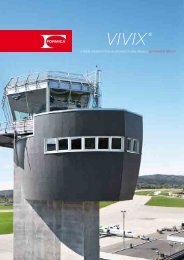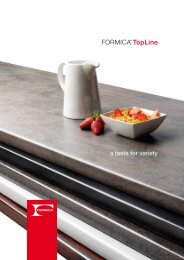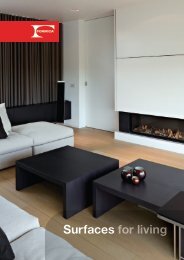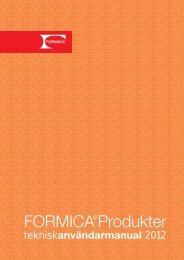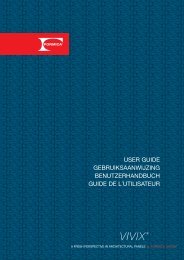Technical Information dispelling traditions - Formica
Technical Information dispelling traditions - Formica
Technical Information dispelling traditions - Formica
Create successful ePaper yourself
Turn your PDF publications into a flip-book with our unique Google optimized e-Paper software.
formica_technical.qxd:formica_technical.qxd 28/11/08 16:01 Page 31<strong>Formica</strong> ® Compact Grade Laminate 2 of 2Profile cutting and edge finishingIt is not necessary to apply edging strips or edge sealants toCompact panels, and for many applications clean sawn edgesare sufficient.A spindle moulder or router may be used to achieve a superiorfinish or a profiled edge. For this type of work PCD tooling isrecommended. Although it is not possible to achieve completefreedom from cutter marks, they can be minimised by feedingthe work at a constant controlled speed by the use of amechanical power feed. Care should be taken to avoid pausingduring cutting and profiling, as burn marks may result whichare difficult to remove. Where it is desirable for edges to becompletely free from cutter marks, a further sanding andscraping operation is necessary. Edges may be further enhancedby buffing with steel wool and applying silicone free oil.Chamfering or profiling the edges of Compact panels will reducethe risk of edge impact damage.DrillingThe most suitable drills for use on Compact laminates are thosedesigned for plastic sheet materials. These drills have a pointangle of 60°- 80° instead of the normal 120° for drilling metal.To avoid breakout on the reverse side, the feed speed of thedrilling head and the pressure applied should be graduallyreduced approaching the point of breakthrough. Workingon a firm underlay, such as plywood or chipboard, willalso reduce the risk of breakout.For blind boring into the face, the depth of the hole should besuch that at least 1.5 mm of material remains between the bottomof the hole and the other side of the sheet. TCT lip and spur drillswill produce clean flat bottomed blind holes, with less risk of pointpenetration on the reverse side. This will allow maximum depthof material to be used for fixings. Compact sheets less than10mm thick are not considered suitable for blind fixing.When drilling parallel to the surface (edge drilling) at least 3 mmof material must remain on either side of the hole. Threaded holescan be produced using engineers screw cutting taps. Self-tappingscrews or threaded brass inserts may also be used.InstallationIn the planning of any installation, it is essential to take intoaccount the dimensional movement that can occur with Compactlaminates and allowances must be made in the design, fabricationand installation processes. Movement in the length direction of thesheet is about half of that in the width direction. Typicaldimensional movement values resulting from extreme changein relative humidity are as follows:Transverse direction of the sheet: 2.5-3.0 mm per metreLongitudinal direction of the sheet: 1.0-1.5 mm per metreCompact panels used for wall cladding may be fixed by screwingdirectly through the face, or by hanging on a rigid supporting timberor metal framework with ‘Z’ clips. Thinner grades, 4-6 mm, may bebonded to a wood-based framework with heavy duty buildingadhesives. The chosen method of attachment will depend onthe installation, board thickness and visual design criteria. In allapplications the panels must be fixed to a rigid secure systemof horizontal supports at not more than 600 mm centres, withvertical support members at the joints appropriate to the detailing.Fixing clips should also be at maximum 600 mm centres. It isrecommended that panels of less than full board width are used,both for ease of handling and reducing dimensional movement.Compact panels should not be fixed to freshly constructedblockwork or brickwork until adequate drying has taken place,nor should they be fixed to damp external walls without theprotection of a damp-proof membrane.Adequate ventilation/air circulation must be provided behind thepanels either by notching the support members or packing themoff the wall. Typical minimum ventilation access at the top andbottom of the panels should be 20 cm 2 per square metre ofpanel area.Direct face fixingThrough fixing holes should be at least 1.5 times the outsidediameter of the screw being used, and should be a minimumof 20 mm from the edge of the panel. Soft plastic bushes should beused to ensure correct centring of the screw in the hole, whilst stillallowing for movement. Countersunk screws should not be used.Attaching fixing devices‘Z’ clips and other secret fixing devices may be attached tothe back of panels with ‘Taptite’ self-tapping screws or threadedbrass expansion inserts. Screws and bolts with slow threadsprovide better resistance to working loose than those with fastthreads. In all cases a blind pilot hole of the correct size mustfirst be bored in the back of the panel. The depth of the holeshould be at least l mm greater than the penetrating depth ofthe screw, and should leave at least 1.5 mm of material betweenthe bottom of the hole and the face of the panel.Rigid items, such as ‘Z’ clips and fixing angles, fixed to Compactpanels, should have oversize holes to accommodate differentialmovement. A slip foil between the two components is alsorecommended. Expansion fasteners should not be usedin edge-drilled holes (i.e. parallel to the surface).Edge-to-edge jointingEdge-to-edge joints may be either tongued and grooved, orsimply grooved and a loose spline inserted. Whichever method ischosen, the wall thickness of the groove should be greater thanthe width of the groove. The depth of the groove should be nogreater than the thickness of the board, and the length of thetongue/spline should be such as to accommodate the maximumanticipated movement. Compact laminates less than 8 mm thickare not suitable for edge grooving.Edge retaining profilesEdge retaining profiles of steel or aluminium should be usedin situations where some movement of adjoining panels isanticipated, such as in vehicle construction.Postformed cornersInternal and external postformed Compact corners can beproduced to a minimum radius of 15 mm and a maximum girthof 300 mm. Check with our Fabrication Support Unit for details.<strong>Formica</strong> Limited, Coast Road, North Shields, Tyne & Wear NE29 8RE. Tel: 0191 259 3000. Fax: 0191 258 2719.<strong>Formica</strong> is a registered trade mark of <strong>Formica</strong> Corporation or its subsidiaries.<strong>Technical</strong> Services Department April 2004.30




